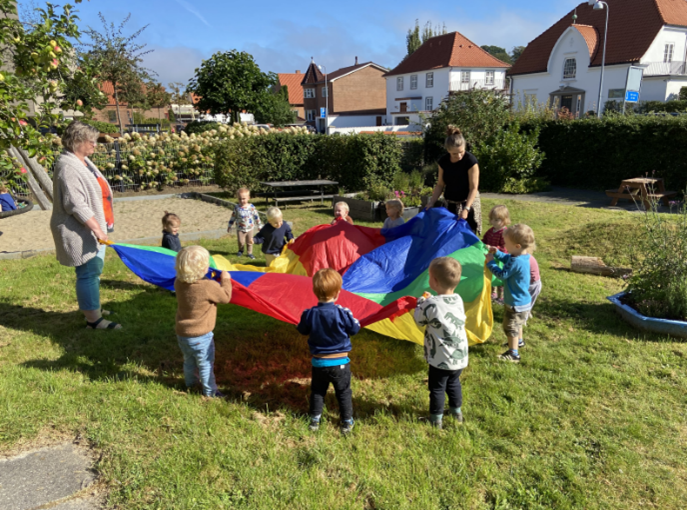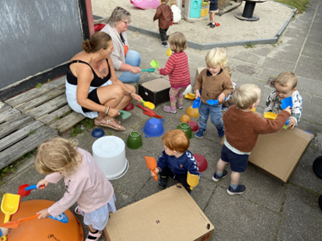MUSIC, OUTDOORS, BILDUNG, PLAY, COMMUNITY
REGION: Middle
MUNICIPALITY: Silkeborg
PROCEDURE: 2023
DAILY OFFER: Arnen
Snudestory: Arnen (2023)
Snude - that's the end of that story. Let's see what we learned...
A point of wonder that we have addressed:
- How can we use the playground to create spaces for musical experimentation and play to engage children in communities of children with appropriate challenges and a desire to explore the environment themselves?
In the start-up reflections, we briefly discussed using singing games that can be based on the environment/playground so that children and adults have a shared experience of singing and music. How can we subsequently create invitations in the environment so that the children themselves want to create games?
Our snap stories and reflections suggest that children are taking singing games and activities into their own playground games.
The PlayArt activities are based on recognizability both in terms of the adults who participate and that Lene comes to visit, as well as recognizability in the activities. Lene is called 'Lene PlayArt' by several children. For example, we have based our activities on a hide-and-seek game that is combined with singing games. The game is structured around the song and hiding places and children who have to hide. The children show signs that they know what to do.
The collaboration with Lene has been good. It has also been good for the children. When someone new comes in from the outside, they seem to absorb more. If we say LegeKunst now, they say Lene. Lene has helped sow a lot of seeds among the employees - we've only just started. In the beginning, we wanted to live up to the things Lene did, but now we are more relaxed about the activities.
We have become aware that there should not be a 100% plan for the activities: Start, middle and an end. It is important to agree on who decides/facilitates the play by the adults, but we are all in it together.
The parachute song game has also been a recurring activity. It is a game that is combined with a focus on the weather, e.g. windy or rainy weather, and songs that support the parachute game. It shows that it's good that we have some concrete things that can be a common third.
Children are good at following a game. This is due to many pedagogical efforts in terms of e.g. taking turns, paying attention, looking out for each other, alternating between larger and smaller groups and joint projects on a common third. We see that children who normally don't participate as much, participate more actively.
During the process, things were impulsively taken out of the shed that could be used for various rhythm instruments - several children were activated. This subsequently means that buckets and shovels are used for many different rhythm games. Pictures (snap stories) show that the children grab the initiated drumming games and drums and continue playing at other times. There are clear connections between children and adults and how they explore drum sounds.
Children don't demand scooters as much anymore. In general, there are fewer vehicles on the playground because we can activate/play with the children in new ways.
The playground has been given some points that have taken on new meaning. The items signal different things. Meanings are created by children and adults - a privet hedge is a hiding place, for example.
Children generally show a high level of engagement and want to play - also with each other. They are very curious. Perhaps the children have also become more accustomed to playing in different/new ways.
We also see children initiating games from the activities on the playground. There are observations that point towards children singing the songs later in the day. Children grasp songs and activities and use them afterwards.
We generally find that we sing more in the playground. The singing can happen randomly - it can be when someone is sitting in the swing or when someone is sad.
"The project has landed where it is realistic in everyday life. The idea has not been to create a large package that can be used pedagogically. PlayArt in everyday life can be small things you do impulsively with the children. The idea has also been to get new ideas on how to use the garden - and we have"
Snude - a new story can begin...
- We want to continue the work we do today. It shouldn't be a regular thing, but it should be spontaneous activities. In the winter, activities can also be carried out indoors.
- We want to make more things to make materials, cans and rhythm instruments more visible and usable. For example, we would like to make mallets and buy some plastic boxes to drum on.
- We are still curious about how we can make it grow in the house so that it also drips on the other adults in the house. The other living rooms need to get more into the garden so they can also see what is being done. This could be in the morning with hide and seek, singing games, rhythm games, parachute, etc.
What points of attention should we have going forward?
- We must continue to be curious about creating pedagogical tools that can create play communities around singing, music and movement.
- Important that we support each other in the different activities we try
- Focus on how we can keep it going - for example, should we laminate something we've talked about that can inspire us (adults and children) to play singing games.
- In terms of the fabulatorium, we have gotten more out of PlayArt. The fact that it has taken place here has been of great importance to us, the children and the place. The development is directly linked to the place where the children and educators are. There has also been more logistics/practice at the fabatorium when we have to go to DKS. When we are in our own house, we may also catch more of the shy children
- In terms of the time perspective, it's been fine, but it's also been an ordeal to do it on our own. We don't really have time for planning, but now we just go down and do it - it's become more of a routine. It was perhaps a bit quick that we had to do it ourselves. Maybe you could spend a little more time with the artist.
click on the picture to see a larger version



